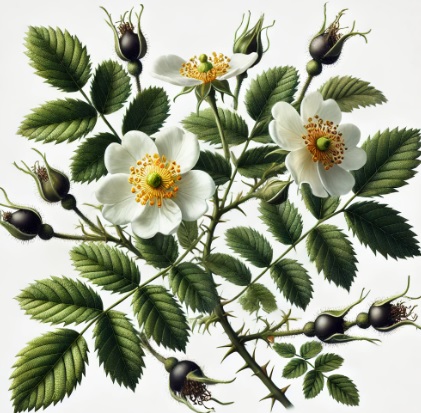Scotch rose (Rosa spinosissima L.) is a species of wild rose native to Europe and parts of Asia. It is distinguished by its spiny stems and small, fragrant flowers. Rosa spinosissima is valued for its ornamental qualities and adaptability to various garden settings.
Botanical Classification:
Kingdom: Plantae
Order: Rosales
Family: Rosaceae
Genus: Rosa
Species: Rosa spinosissima
Plant Characteristics:
Rosa spinosissima is characterized by:
Flowers: Small to medium-sized flowers, usually white or pale pink, with a delicate fragrance. The flowers typically bloom in late spring to early summer.
Foliage: Dark green, glossy leaves with a pinnate structure and serrated edges. The leaves are complemented by the plant's thorny stems.
Growth Habit: A compact, dense shrub that typically grows to a height of 1 to 1.5 meters. It has a rounded growth habit with numerous thorns along its stems.
Soil and Light: Prefers well-drained soil and full sunlight. It is hardy and adaptable to a variety of soil conditions, thriving best in a sunny, open location.
Chemical Composition and Structure:
The chemical composition of Rosa spinosissima includes:
Essential Oils: Contains aromatic compounds such as geraniol and citronellol, contributing to its subtle fragrance.
Flavonoids and Tannins: Present in the leaves and flowers, providing antioxidant and astringent properties.
Organic Acids: Found in the foliage and flowers, contributing to the plant’s aromatic profile and potential health benefits.
Uses and Benefits:
Aesthetic: Appreciated for its charming, fragrant flowers and spiny stems, making it a popular choice for ornamental gardens and hedges.
Cosmetic: Extracts are used in skincare products for their mild astringent properties and fragrance.
Medicinal: Traditionally used in herbal medicine for its potential anti-inflammatory and soothing effects, though scientific evidence supporting these uses is limited.
Culinary: The rose hips can be used to prepare herbal teas and infusions, offering a mild flavor and a source of vitamin C.
Applications:
Gardening: Used as an ornamental shrub or hedge in gardens for its attractive flowers and unique spiny appearance.
Cosmetics: Extracts incorporated into skincare products for their astringent and fragrant qualities.
Medicinal: Utilized in traditional herbal remedies for its potential soothing and anti-inflammatory benefits.
Culinary: Rose hips used in teas and infusions for their flavor and vitamin C content.
Environmental and Safety Considerations:
Environmental Impact: Hardy and adaptable to various garden environments; supports garden biodiversity and provides habitat for local wildlife.
Safety: Generally safe to handle and use; individuals with allergies or sensitivities should exercise caution. Consult a healthcare provider before using Rosa spinosissima for medicinal purposes.
INCI:
Surfactant - Foam booster. It has the effect of introducing gas bubbles into the water and affects the cleaning process by helping to spread the cleanser. Since sebum has an inhibiting effect on the bubble, more foam is produced in the second shampoo.
Synonyms:
CAS: 97593-52-7 EC number 307-357-4
![]() Scotch rose
Scotch rose 

